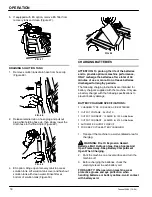
OPERATION
22
Tennant 5280 (10--04)
QUARTERLY MAINTENANCE
(Every 250 Hours of Use)
Check the vacuum motor and the brush motor for
carbon brush wear. Replace carbon brushes when
worn to a length of 10 mm or less.
Contact an Authorized Service Center for
machine repairs.
WARNING: Electrical Hazard. Disconnect
Battery Cables Before Servicing Machine.
BATTERY MAINTENANCE
WARNING: Fire Or Explosion Hazard.
Batteries Emit Hydrogen Gas. Keep Sparks And
Open Flame Away. Keep Battery Compartment
Open When Charging.
FOR SAFETY: When servicing machine, wear
protective gloves and eye protection when
handling batteries and battery cables. Avoid
contact with battery acid.
1. Check the specific gravity using a hydrometer to
determine the charge level and the condition of the
batteries (Figure 65). If one or more of the battery
cells read lower than the other battery cells (0.050
or more), the cell is damaged, shorted, or is about
to fail. Check the hydrometer readings against the
following chart to determine the remaining battery
charge level.
NOTE:
Do not take readings immediately after adding
distilled water. If the water and acid are not thoroughly
mixed, the readings may not be accurate.
FIG. 65
SPECIFIC GRAVITY
at 27
°
C
BATTERY
CHARGE
1.265
100% CHARGED
1.223
75% CHARGED
1.185
50% CHARGED
1.148
25% CHARGED
1.110
DISCHARGED
NOTE:
If the readings are taken when the battery
electrolyte is any temperature other than 27
_
C (80
_
F),
the reading must be temperature corrected. Add or
subtract to the specific gravity reading 0.004, 4 points,
for each 6
_
C (43
_
F) above or below 27
_
C (80
_
F).
2. Always follow proper charging instructions
(See CHARGING BATTERIES).
3. Check the electrolyte level (A) in each battery cell
after charging batteries
. The level should be
approximately 1 cm (.375 in) from the bottom of
the fill--port (B). Add distilled water if needed
(Figure 66) DO NOT OVERFILL.
A
B
FIG. 66
4. Keep the battery tops clean to prevent battery
corrosion.
To clean batteries:
FOR SAFETY: When servicing machine, wear
protective gloves and eye protection when
handling batteries and battery cables. Avoid
contact with battery acid.
a. Mix a strong solution of baking soda and water
(Figure 67).
FIG. 67
b. Brush the solution sparingly over the battery
tops and cable connectors.
NOTE:
Do not allow baking soda solution to enter
battery cells.
c. Use a wire brush to clean the battery terminals
and cable connectors.
d. After cleaning, apply a coating of clear battery
post protectant to the terminals and cable
connectors.
5. Check for loose or worn cables. Replace if worn.
















































